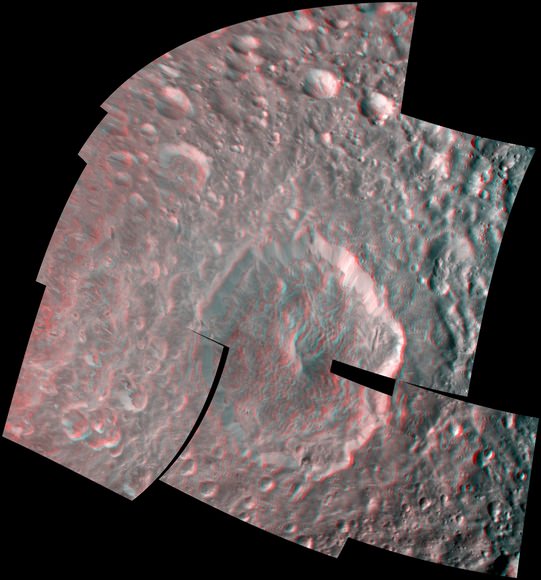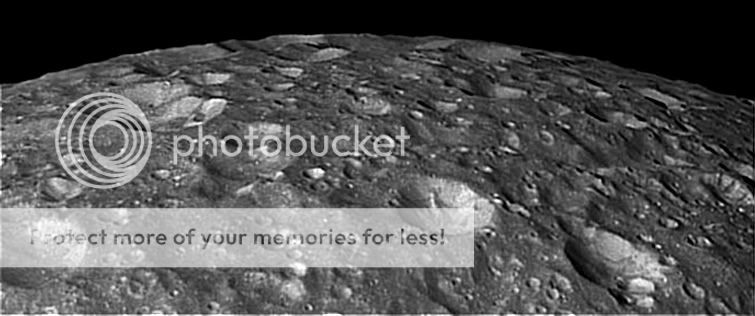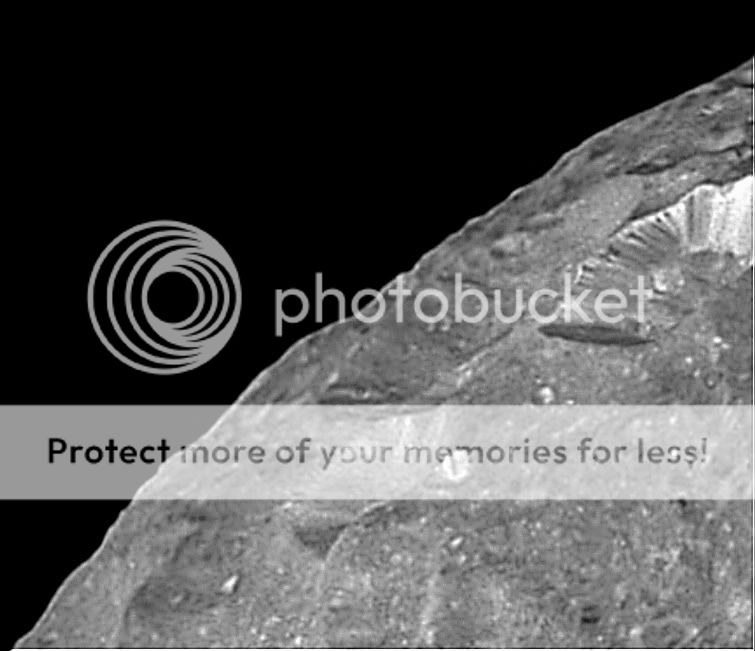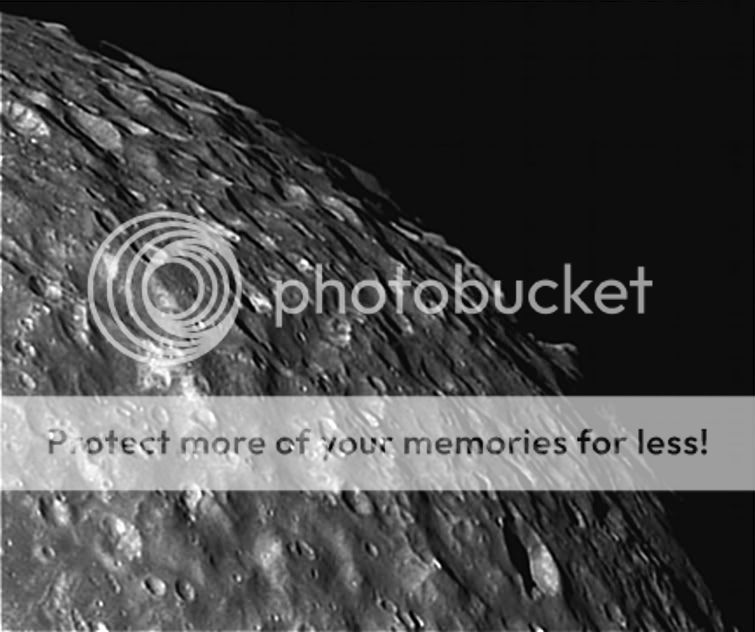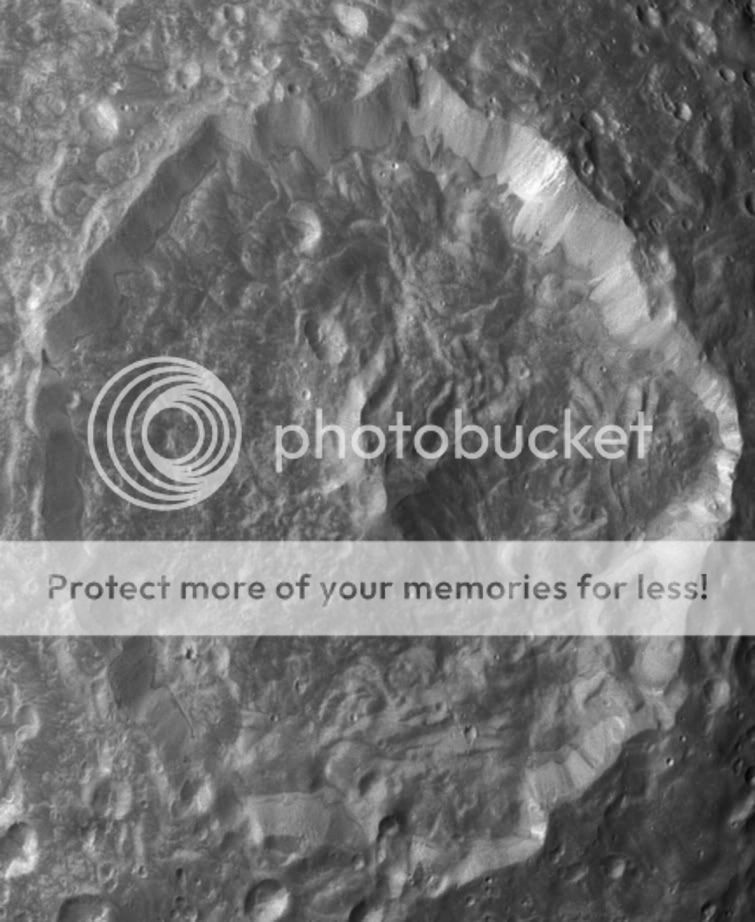3
3488
Guest
On Saturday 13th February 2010, the Cassini spacecraft approached Mimas & passed by at approx 9,600 KM, the closest pass of the innermost of Saturn's major moons & will be the closest during the entire mission.
Mimas is 395 KM wide & orbits Saturn at a distance of 185,500 KM once every 22 Hours & 36'. Mimas has a density of only 1.15 G/CM3 or only 15% greater than pure ice. Mimas therefore is mostly ice with a little rock.
I have consolidated all of the images I worked on & put them here in one place.



Another nice Mimas image from approx 72,000 KM. Using the UV filter.

Another view of the Herschel Crater.

Enlarged sharpened crop of the central mountain in the Herschel Crater on Mimas.

Enlarged & sharpened crop of Section of Herschel Crater wall & floor on Mimas. What is immediately obvious is the lack of small craters on the floor of Herschel Crater. Landslide debris covering the original floor perhaps? Or is Herschel Crater fairly young?

Does look like crater slumping has occured.
Another enlarged crop of the rim of Herschel Crater. It is quite apparant that material has slumped & striations visible on the crater wall.

Below, two enlarged crops of the limb of Mimas I did. I rotated them so they look like an horizon. Both crops are approx 30 KM wide & have been contrast enhanced. Looks almost like a view as if coming in to land!!!! Some of those mountains are approx 2,000 - 3,000 metres high IMO.


The 130 KM wide, 5 KM deep Herschel Crater crop during approach. It is worth bearing in mind that Mimas is only 395 KM across.

Mimas. NE of Herschel Crater rim & a curious depression.

Mimas. Northern Rim of Herschel Crater & area north. Impact melt appears to have smoothed much of the terrain.

Curious Depression on Mimas to the N E of Herschel Crater. Feature is approx 100 KM long N - S.

Mimas. Southern portion of Herschel Crater with elliptical secondaries & valleys radiating away outside to the south. The crater on the bottom right of this cropped frame also has had landslides.

Mimas. SW floor of Herschel Crater. The base of the central mountain is visible in the top right. Note how few small craters are visible here. This is quite a surprise assuming Herschel Crater is ancient.

NW limb of Mimas, showing the very cratered & rough terrain on this ice moon of Saturn.

SW limb of Mimas. Some of these larger craters appear to have been formed from double impactors?? Wayne, what do you think? Some of these craters show striations on their walls.

Andrew Brown.
Mimas is 395 KM wide & orbits Saturn at a distance of 185,500 KM once every 22 Hours & 36'. Mimas has a density of only 1.15 G/CM3 or only 15% greater than pure ice. Mimas therefore is mostly ice with a little rock.
I have consolidated all of the images I worked on & put them here in one place.



Another nice Mimas image from approx 72,000 KM. Using the UV filter.

Another view of the Herschel Crater.

Enlarged sharpened crop of the central mountain in the Herschel Crater on Mimas.

Enlarged & sharpened crop of Section of Herschel Crater wall & floor on Mimas. What is immediately obvious is the lack of small craters on the floor of Herschel Crater. Landslide debris covering the original floor perhaps? Or is Herschel Crater fairly young?

Does look like crater slumping has occured.
Another enlarged crop of the rim of Herschel Crater. It is quite apparant that material has slumped & striations visible on the crater wall.

Below, two enlarged crops of the limb of Mimas I did. I rotated them so they look like an horizon. Both crops are approx 30 KM wide & have been contrast enhanced. Looks almost like a view as if coming in to land!!!! Some of those mountains are approx 2,000 - 3,000 metres high IMO.


The 130 KM wide, 5 KM deep Herschel Crater crop during approach. It is worth bearing in mind that Mimas is only 395 KM across.

Mimas. NE of Herschel Crater rim & a curious depression.

Mimas. Northern Rim of Herschel Crater & area north. Impact melt appears to have smoothed much of the terrain.

Curious Depression on Mimas to the N E of Herschel Crater. Feature is approx 100 KM long N - S.

Mimas. Southern portion of Herschel Crater with elliptical secondaries & valleys radiating away outside to the south. The crater on the bottom right of this cropped frame also has had landslides.

Mimas. SW floor of Herschel Crater. The base of the central mountain is visible in the top right. Note how few small craters are visible here. This is quite a surprise assuming Herschel Crater is ancient.

NW limb of Mimas, showing the very cratered & rough terrain on this ice moon of Saturn.

SW limb of Mimas. Some of these larger craters appear to have been formed from double impactors?? Wayne, what do you think? Some of these craters show striations on their walls.

Andrew Brown.




